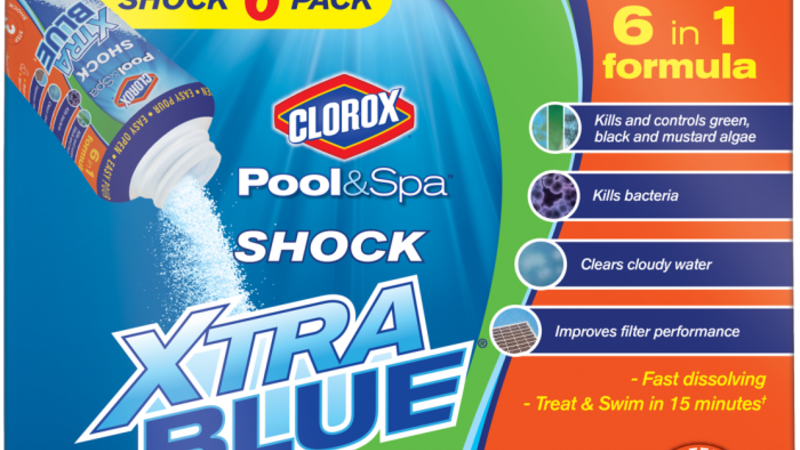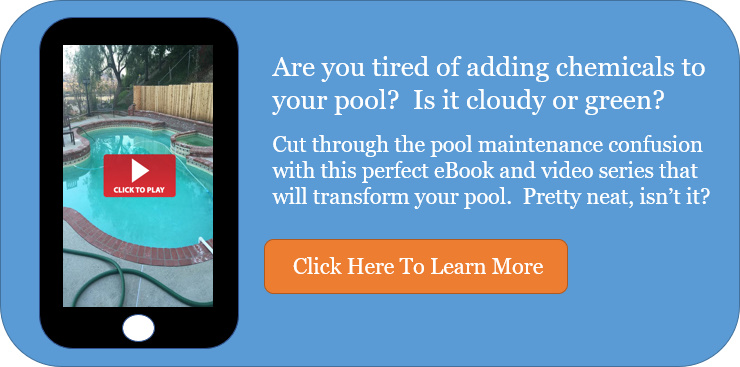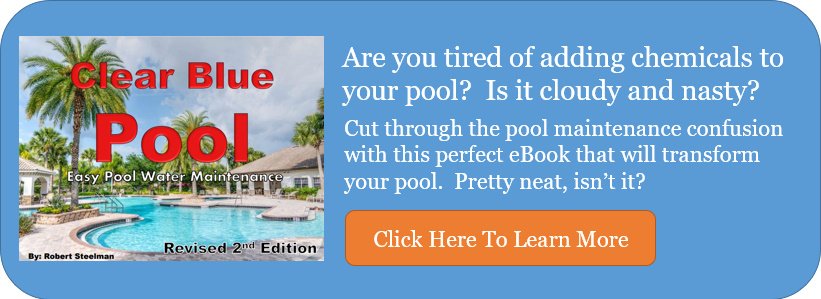How To Shock A Pool The Right Way
Once you understand what pool shock is and the proper steps to take, the entire process will seem very easy and can be done when your pool needs it. Some really good questions to ask when shocking your pool are these:
- Why should I shock my pool?
- The pool store said to "put some shock in it". Should I?
- Is there such thing as too much shock?
- Is super chlorination right?
Here are the real answers every pool owner needs to know.

What Is Chlorine Pool Shock?
Pool shock is basically adding enough chlorine to your pool to kill off any and all algae spores, bacteria, excess swimmer's waste, pollen, dirt particles, and anything else that may fall into your pool. Have you ever visited an outdoor public pool? Or maybe in indoor public pool? Ever notice that foul "chlorine smell"? If you have, what your sniffer sniffed out was dead and dying bacteria in the pool, also known as chloramines. It's these chloramines that give off the smell.
In addition to smelling funny, chloramines can also irritate your eyes, ears, skin, and respiratory system.
When dealing with chloramines, the best and most cost effective way to get rid of them is to use a good pool shock and literally “blast” them out of the pool with a high dose of pool chlorine. This is also called “super-chlorination” which kills algae. Normally, you’ll want to bring up the chlorine level 10 times per every 1ppm of pool chlorine, or a 10:1 ratio. There are also many non-chlorine shock products on the market, such as potassium monopersulfate. MPS does not shock the pool in the same way as chlorine does. It will not beak down chloramines already in the water. Regular chlorination also offers safe swimming for you and your swimmers.
It’s an “all or nothing” approach, so don’t skimp on the pool chlorine. When you super-chlorinate your pool, you must go all out and shock your pool all at once, not over a few hours days. Using less or skimping on pool chlorine will only make your swimming pool problems worse and the chloramines and bacteria will only get stronger and more resistant to future pool shocking treatments. Remember, you must use your pool chlorine and “slam it” or the chloramines, bacteria, and contaminants will return.
What Are The Different Types Of Chlorine Readings?
Glad you asked. But first, we should look at their difference and definitions, and they are:
- Free Chlorine (FC): The amount of active chlorine in your pool that can disinfect your pool water. You want your water’s FC level to be between 2 - 4 ppm.
- Combined Chlorine (CC): The amount of chlorine that’s been used. This still registers as chlorine, but it has no more power to kill organics in the pool. Your CC should be below 0.2 ppm.
- Total Chlorine (TC): The sum of FC and CC in your pool.
In order to know your actual FC, TC, and CC, you will need a good test kit such as the Taylor K-2006. Regular 4 way kits, yellow OTO kits, and test strips cannot give you the numbers you need.
When you do shock your pool, you will need to hit what's know as break point chlorination. This is understood as an increase to your chlorine level up 10 - 12 times your CC reading.
Types Of Pool Shock
While pool shock is really a process and not a product, we'll still go on the current verbiage that is known to most pool owners.
Calcium Hypochlorite
Also known as cal hypo or chlorine granules, this kind of pool chlorine has been used for decades and is one of the least expensive and convenient ways to chlorinate your pool.
Features
- Most concentrated versions can contain between 65% and 75% available chlorine.
- Calcium hypochlorite should be dissolved in a bucket filled with pool water before adding it to your pool.
- Places that have hard fill water may not want to use calcium hypo. It can raise the hardness of the pool water and affect your pH levels.
Sodium Hypochlorite
Also known as bleach. A very efficient and cost effective way to chlorinate your pool. Sodium hypochlorite can contain between 8.5% and 10.5% per 1 gallon.
Features
- Easy to apply and very effective at killing organic matter.
- Can be added to a bucket filled with pool water, but not required.
- Can be used in any environment and pool condition.
- I use and recommend it.
Lithium Hypochlorite
Granular chlorine that's fast acting and dissolves quickly, much faster that calcium hypochlorite.
Features
- Can contain up to 35% available chlorine.
- Its higher price doesn't make it a good choice for chlorination and does nothing more than regular bleach.
Dichlor & Trichlor Stabilized Chlorine
The actual names of these are Sodium Dichloro-S-Triazinetrione (dichlor) which contains between 58% and 62% active chlorine. TriChloro-S-Triazinetrione (trichlor) is more common in chlorine tablets and contains upwards of 90% active chlorine.
Features
- They typically contain higher levels of chlorine.
- Can be used to shock the pool under certain circumstances.
- You typically don’t have to dissolve it ahead of time.
- Both add CYA/stabilizer to the pool.
Non-Chlorine Shock
Non-chlorine shock normally contains potassium peroxymonosulfate as the ingredient. It's a fast and inexpensive pool shock alternative for those that might be sensitive to chlorine.
Features
- No dilution needed. You can add it directly to your pool water.
- Dissolves quickly.
- Higher price than bleach.
How Often Should You Super-chlorinate Your Pool?
This is an area of debate, but after being in the pool business since 1999 and clearing up over 700 nasty green and cloudy pools in 3 different states, I can say with much confidence that weekly "shocking" of your pool is unnecessary. Maintaining the proper pool water chemistry and a residual chlorine level of either 2 - 4 ppm or 3 - 5 ppm is normally more than enough to kill organic matter in the pool.
That being said, you may want to shock your pool under certain circumstances, such as after:
- Heavy pool use
- A severe rainstorm
- An accident in the pool such as vomit or fecal matter
How To Shock A Pool
Always remember it's safety first. Before you begin: make sure your filtration system is properly working and all of the other readings are in line; the pH, total alkalinity, and hardness.
To start with, you'll need:
- Pair of heavy duty rubber gloves.
- Safety goggles.
- Pool chlorine. I prefer liquid chlorine for pools over calcium hypochlorite, especially if you have hard water levels.
- Large bucket.
- A stir stick or pool pole.
You'll want to shock your pool either in the late afternoon or early evening to allow the chlorine to do its job for the longest amount of time.
- Scoop out as much debris as possible. The only thing you want soaking up your good pool shock is the water.
- Fill the bucket up about 1/2 full of water.
- Add the correct amount of pool chlorine into the bucket. It's 1 gallon of liquid chlorine per 10,000 gallons of pool water.
- Stir the mixture with a good stir stick.
- Broadcast it around the perimeter of the pool starting in the deep-end and working around. Be sure the filtration system is running and everything is working properly.
- Test the water approximately 10 hours later to be sure your super-chlorination was successful.
It must be stated here that shock is absolutely NOT a product we buy. It's a PROCESS we do. The packages of shock are nothing more than stabilized or unstabilized chlorine. In fact, the chemicals added to "stabilize" the chlorine can cause a whole host of costly problems for your pool if you use it too often.
How Long After I Shock My Pool Can I Swim?
There's really no consensus as to how long you will need to wait until you can re-enter the water. A good rule of thumb is to follow the manufacturer’s instructions on the back of the product. Most directions on the back of the package will offer precaution warnings and tips for storage. Your best bet is to test the chlorine level to be certain that your water is safe before returning to swim. Once your free chlorine level is in an acceptable range and you can see the bottom of your pool, you should be able to resume your normal swimming activities.
Pool Shock Safety
Shocking your pool is something you may need to do from time to time, but the utmost caution must be taken. We're dealing with chemicals, and to put it lightly, some chemicals don't play nicely with other chemicals. To be blunt, they're very dangerous and could cause serious harm to you and your pool plumbing if they're not properly handled and stored.
- Always wear protective clothing such as goggles, gloves, long pants and shirts.
- Do not store liquid pool shock over dry chemicals.
- Next mix different types of chemicals. Example: mixing chlorine and muriatic acid in a bucket.
- Add one chemical at a time to your pool.
- Avoid breathing in chemical fumes and vapors.
- Always follow the manufacturer's directions on the packages.
Pool Shock, And You
Everyone loves a crystal clear pool. And with the right information and the right tools, it's much easier to keep it that way. Defeat the algae and bacteria, and you're on your way to a great swim party this weekend, or a relaxing dip after a hard day's work.
What Other Visitors Have Said
Click below to see contributions from other visitors to this page...
Green Pool With Cloudy Water 




Thanks so much for your website.
We are new to taking care of a 10,000 gallon in-ground pool. We live in south Texas where it is muggy and hot. Our …
High Cynaric Acid Not rated yet
My pool is a 26,000 gallon above ground vinyl liner. around 7/31/2014 the cya raised to 113 and then my water started clouding up.
8/5/2014 stopped …

